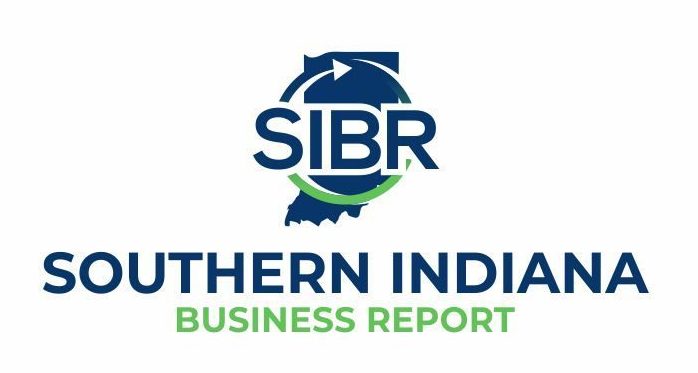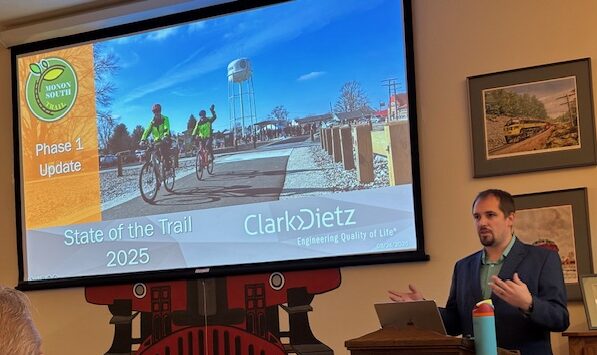Carol Johnson, Southern Indiana Business Report
SALEM – Upon full completion of the Monon South Trail, the economic impact of the 60 miles of trail on local economies is projected to range from $2.1 million to $6.9 million annually.
The Eppley Center for Parks and Public Lands at Indiana University released its economic impact projections for the Monon South Trail Tuesday during the Radius Indiana State of the Trail meeting held at the Depot Museum in Salem. The economic impact analysis was done in partnership with Radius Indiana, the trail developer.
The Eppley Center estimates that the Monon South Trail, which will span from Lawrence County down to Clark County, will attract between 25,000 and 93,000 non-local users per year. With an anticipated daily spending of $42-$103 by non-local users, those visitors will have a significant impact on the nine communities located along the trail.
“Trails are economic drivers,” said Kristina Anderson, research scientist at the Eppley Center. “Non-local users are the primary drivers of economic development because they bring ‘new’ money to the economy.”
Anderson said the projected economic impact was determined by an evidence-based comparison of seven other trails, including four in Indiana.
Anderson said the study projects that annual spending per mile of trail will range from $34,000 to $111,000.
It’s widely known that trails provide recreation, social and health benefits. Quantifying the economic benefits is important as trail communities identify what amenities or assets trail users value that are lacking in their towns.
Jeff Quyle, CEO and president of Radius Indiana, said the Eppley survey shows the economic benefits trails have on local economies.
“Radius is an economic development organization, so we’ve made the goal of downtown business revitalization a key component of our approach to development of the Monon South as it passes through our communities,” Quyle said. “This study is conservative in its approach, yet it still projects a greater economic boost for the Trail than the impact the March Madness First Four games bring to Dayton, Ohio every year. We’ll continue to work with local leaders to support local small business growth in all our communities along the Trail. And this is in addition to the quality of life it brings to our local residents; we already see daily evidence that community residents are diligently using the Trail.”

The study also included listening sessions with community constituents and trail users. Cycling was reported as the most popular trail activity and physical activity was the most frequently reported motivation for trail used. Sufficient lodging, which can include camping and Airbnbs, was identified as a gap along the trail and trail users said they would like to see historical and cultural assets incorporated into the trail.
Construction timeline update
Construction on the first 20 miles of trail, known as Phase 1, began in July 2024. Completion of Phase 1, which focused on paving segments in six communities, should be completed this summer. David Wichman of Clark Dietz, the engineering firm designing the trail, said the Campbellsburg and Borden sections of the trail are projected for completion in May and Salem and Pekin sections are tentatively set for completion in June. The Orleans and Mitchell sections were completed a few months ago.
“Our goals have been designing a trail that was usable and aesthetically pleasing,” Wichman said.
Phase 1 also includes construction of trailheads. Wichman said trailhead construction will take place over the spring/summer months. MAC Construction of Louisville is paving the trail and Temple & Temple Excavating and Paving is building the trailheads.
Construction has had its challenges. Wichman said a rail bed is a great foundation for building a trail, but the line had been untended for 15 years. Engineers also were tasked with fortifying or rebuilding 11 bridges along Phase 1.
The trail will also include interpretive signage to tell the story of the trail’s Monon Railroad history as well as its unique geologic features and agriculture. Ron Taylor of Taylor Siefker Williams Design said more than two dozen interpretive signs will be erected along the trail.
The Monon South Trail is part of the state’s Next Level Trail program and received $29.5 million in state funds to start the project.
Support for trail, digital storefront
Also in development for the trail are public art elements to create photo memories for trail users.
Radius will also be launching a pitch competition for small businesses located near or adjacent to the trail. Also coming soon, Monon South Trail merchandise can be purchased from the digital storefront, www.mononsouth.com.
Trail enthusiasts who want to help with trail maintenance can become supporters of the trail by becoming one-time or monthly donors. A new link on the Monon South Trail website lets trail fans donate conveniently. Funds will be placed in an endowment at the Washington County Community Foundation.



